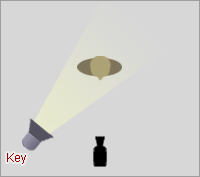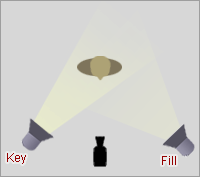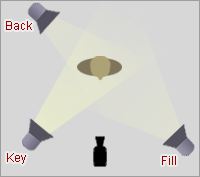The
Three Point Lighting Technique is a standard method used
in visual media such as video, film, still photography and
computer-generated imagery. It is a simple but versatile system which
forms the basis of most lighting. Once you understand three point
lighting you are well on the way to understanding all lighting.
The technique uses three lights called the
key light,
fill light and
back light.
Naturally you will need three lights to utilise the technique fully,
but the principles are still important even if you only use one or two
lights. As a rule:
- If you only have one light, it becomes the key.
- If you have 2 lights, one is the key and the other is either the fill or the backlight.

Key Light
This is the main light. It is usually the strongest and has the most
influence on the look of the scene. It is placed to one side of the
camera/subject so that this side is well lit and the other side has some
shadow.

Fill Light
This is the secondary light and is placed on the opposite side of the
key light. It is used to fill the shadows created by the key. The fill
will usually be softer and less bright than the key. To acheive this,
you could move the light further away or use some spun. You might also
want to set the fill light to more of a flood than the key.

Back Light
The back light is placed behind the subject and lights it from the
rear. Rather than providing direct lighting (like the key and fill), its
purpose is to provide definition and subtle highlights around the
subject's outlines. This helps separate the subject from the background
and provide a three-dimensional look.
If you have a fourth light, you could use it to light the background of the entire scene.




No comments:
Post a Comment